
Objectives of the service
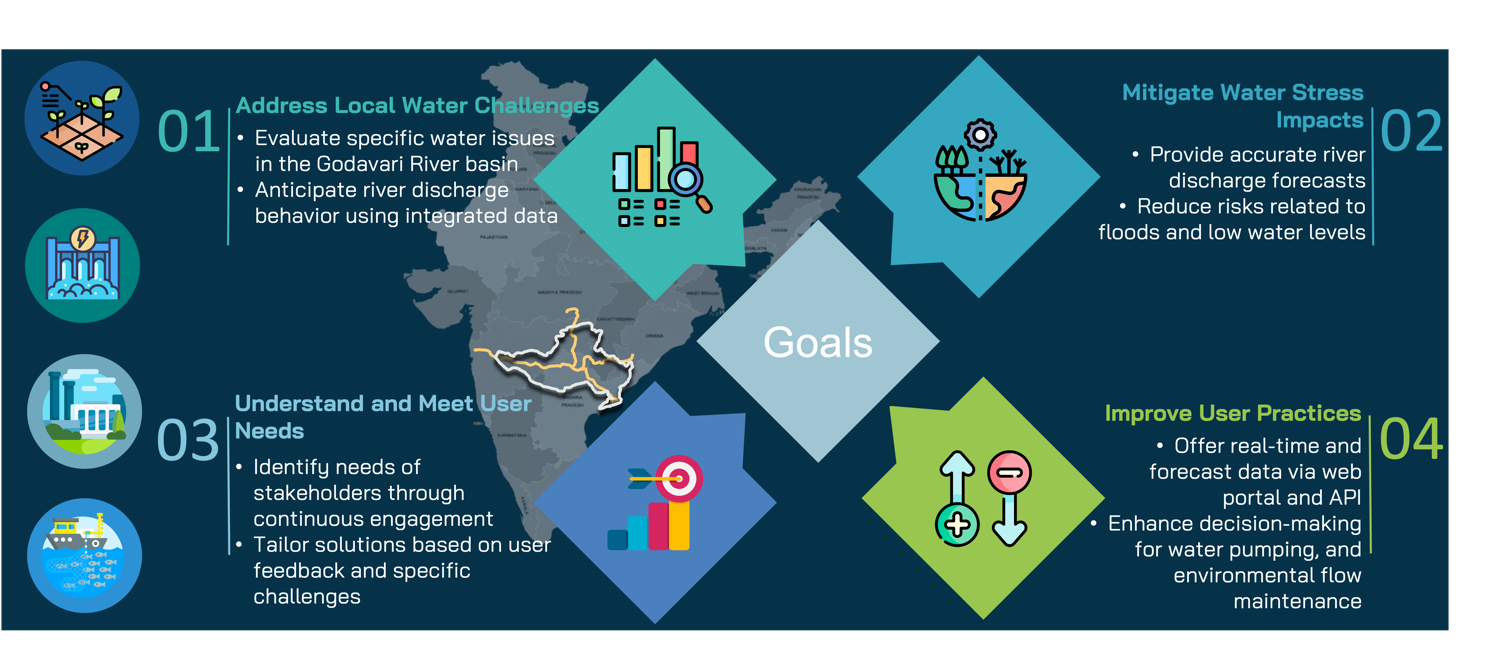
Data4Water addresses the multifaceted water management challenges in the Godavari River basin, a pivotal area designated as a Water Resilience Coalition priority. Farmers face uncertainties in irrigation, hydropower companies navigate river discharge fluctuations, and fishery activities seek consistent resources for the continuity of the livelihoods. Local authorities manage water resources amid seasonal variations and climate change impacts.
Data4Water is dedicated to addressing the multifaceted water management challenges in the Godavari River Basin. Our primary objectives are to provide precise real-time and forecast discharge data to various sectors, support agriculture with informed water use, ensure ecological balance through minimum environmental flows, and mitigate the impacts of floods and droughts. By integrating Earth Observation data, in-situ measurements, and advanced hydrological models, we aim to enhance the resilience and sustainability of water management practices in the region. Our service is tailored to address specific challenges faced by users, including mitigating water scarcity risks, managing low water levels, and optimizing water-related practices.
The project strategically engages in Customer Identification, Value Proposition Definition, Technical and Commercial viability Assessment guiding the project towards the development of a proof of concept and the preparation for service implementation through continuous user engagement. By understanding user challenges and integrating advanced technologies, Data4Water aims to be more than a feasibility study. It represents a commitment to transforming water management in the Godavari basin through technology, collaboration, and sustainability.
Users and their needs
In India, our targeted users span vital sectors, including agriculture and farming, fishery management, food production, and water advocacy in the Godavari region. Through extensive user engagement and workshops, we have identified the main challenges faced in the Godavari River Basin.
Engagement with stakeholders across various sectors, including agriculture, fishery, and food, underscored a strong interest in addressing critical water-related challenges, highlighting customer desirability. Frequent drought events lead to water scarcity, posing significant challenges to agriculture and essential water uses. Inefficient water pumping practices during low water periods exacerbate the strain on resources, affecting ecosystem health.
We evaluated the feasibility of predictive models for river discharge forecasting and data handling/quality. This provided a foundation for the development of our Proof of Concept (PoC), ensuring technical viability. Poor water quality threatens agricultural productivity and human health. Fluctuating river conditions disrupt fish reproduction, reducing fish populations and impacting livelihoods.
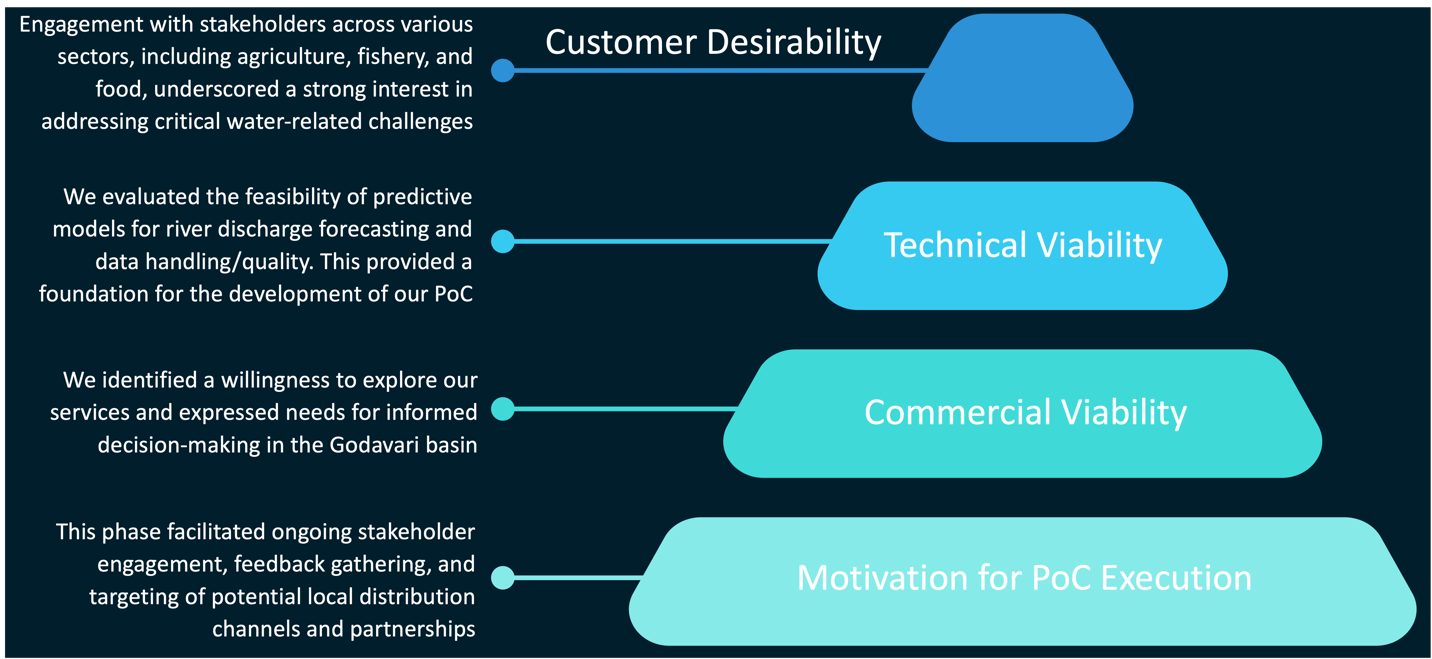
We identified a willingness to explore our services and expressed needs for informed decision-making in the Godavari basin. This affirmed the commercial viability of our solutions, indicating market demand and readiness for implementation. Political and socio-economic factors contribute to inter-district conflicts over water use. The lack of comprehensive real-time data hampers robust decision-making and effective water management.
This phase facilitated ongoing stakeholder engagement, feedback gathering, and targeting of potential local distribution channels and partnerships, motivating us to proceed with the PoC execution. Addressing these challenges head-on, we aim to contribute to the resilience and sustainability of water practices in the Godavari River Basin.
Service/ system concept
Data4Water Capability and User Information:
Data4Water delivers accurate river discharge estimates and forecasts over the Godavari River basin, empowering users with crucial insights for decision-making. Key features include:
-
Optimal Pumping Times: Users can identify the optimum time for pumping and releasing water, minimizing the risk of low water levels, maintaining pollutant concentrations, and positively impacting water quality.
-
Spatial and Temporal Resolutions: The system provides river flow estimates and forecasts at user-defined points with adapted spatial resolutions, aligning with the frequency of weather forecast updates adapted for hydrological applications.
-
Data Consistency: Ensures reliable data products by harmonizing information from various sources, weather data, and historical river discharge, enhancing the overall accuracy.
-
Web Portal and API Accessibility: Users can access data through the system's user-friendly web portal and API, facilitating the visualization, access, and download of river discharge data. This system offers an intuitive interface for interaction, advanced functions, and facilitates ease of use and integration with external systems.
System Operation in Simple Terms:
Data4Water operates as a smart water management decision-making tool for the Godavari River basin. It combines weather forecasts, satellite data, and in-situ data to predict river discharge behavior. Users, such as farmers and authorities, access the information through a user-friendly website or even more “sophisticated” information systems.
System Architecture Overview:
-
Data Foundation: Utilizing Amazon S3, the Data Foundation efficiently manages raw data in a cloud-based Data Lake, while Mapbox's Tiling Service organizes georeferenced data. A structured database (PostGIS, PostgreSQL) ensures consistency and efficient access.
-
Model: Data Collectors periodically gather external data using Python and Kubernetes, Pre-processors transform raw inputs into catchment-specific data, and Modelling Services, powered by neural networks, estimate river discharges.
-
Interface: FastAPI-driven API Server exposes data with modularity, and Clients, employing web components and Vue, provide intuitive user interaction, facilitating data visualization and access.
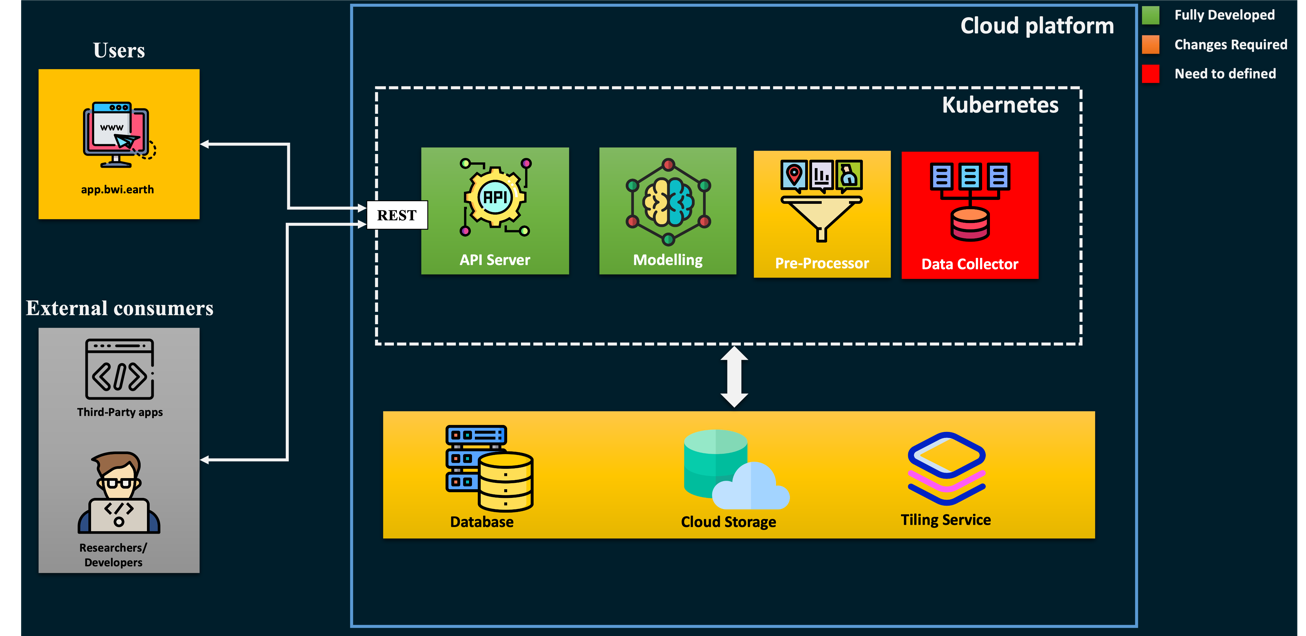
Space Added Value
Leveraging space assets such as SRTM, Copernicus, ASTER, and EUMETSAT data, Data4Water provides unparalleled advantages over traditional methods. Satellite-derived inputs offer comprehensive and real-time insights into the hydrological system, enabling accurate modelling and forecasting of river behavior. This dynamic and high-resolution data enhances the precision of discharge estimates, providing a holistic perspective essential for understanding complex hydrological dynamics. The integration of space assets not only improves accuracy and reliability but also offers a cost-effective and scalable solution, setting Data4Water apart from competitors relying on conventional approaches. This capability ensures more informed and timely decision-making for water management practices.
Current Status
The Data4Water project, initiated in July 2023, has made significant strides in enhancing water management practices in the Godavari River Basin. Since the kick-off meeting in October 2023, we have successfully completed several key milestones:
-
Business Assessment Phase: By December 2023, we identified agriculture and agri-food sectors as champion users. Extensive engagement with stakeholders across these sectors, including research, fishery, food industry, NGO, advocacy, and agriculture, helped us understand their specific needs and challenges.
-
Technical and Commercial Viability: We rigorously assessed the technical and commercial feasibility of our solutions. This involved developing a comprehensive framework for integrating Earth Observation data, in-situ measurements, and advanced hydrological models.
-
Proof of Concept (PoC): In March 2024, we developed and presented our PoC, demonstrating the accuracy of our river discharge predictions and the robustness of our technical approach. The PoC was showcased in a workshop in April 2024, attended by 15 stakeholders from diverse sectors such as research, fishery, food industry, NGO, advocacy, and agriculture.
-
User Engagement and Feedback: Valuable feedback from stakeholders during and after the workshop helped refine our service. This feedback highlighted the practical applications of our tool in optimizing water use, improving fishery management, and supporting agricultural planning.
-
Partnerships and Commitments: We secured strong stakeholder interest and commitments, including letters of intent and financial commitments from key partners across various sectors. Collaboration with governmental entities, commercial partners, and local experts has been instrumental in advancing the project.
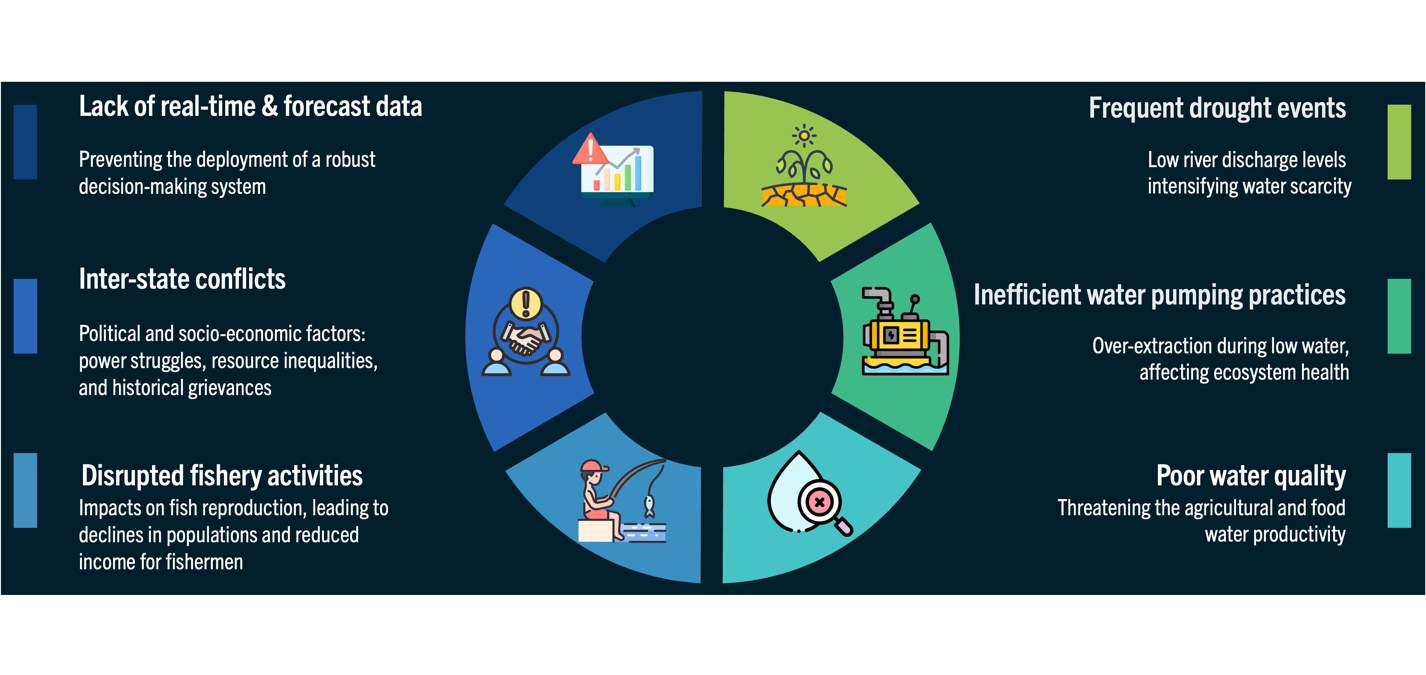
Identified challenges and focus areas include frequent drought events leading to water scarcity, inefficient water pumping practices affecting ecosystem health, poor water quality threatening agricultural productivity, disrupted fishery activities impacting livelihoods, inter-district conflicts over water use, and the lack of real-time data hampering effective water management.
The project is now focused on preparing for the operational phase, with a potential transition expected in November 2024. This phase will mark the start of service deployment, leveraging the insights and feedback gathered to ensure our solution meets the needs of users effectively.
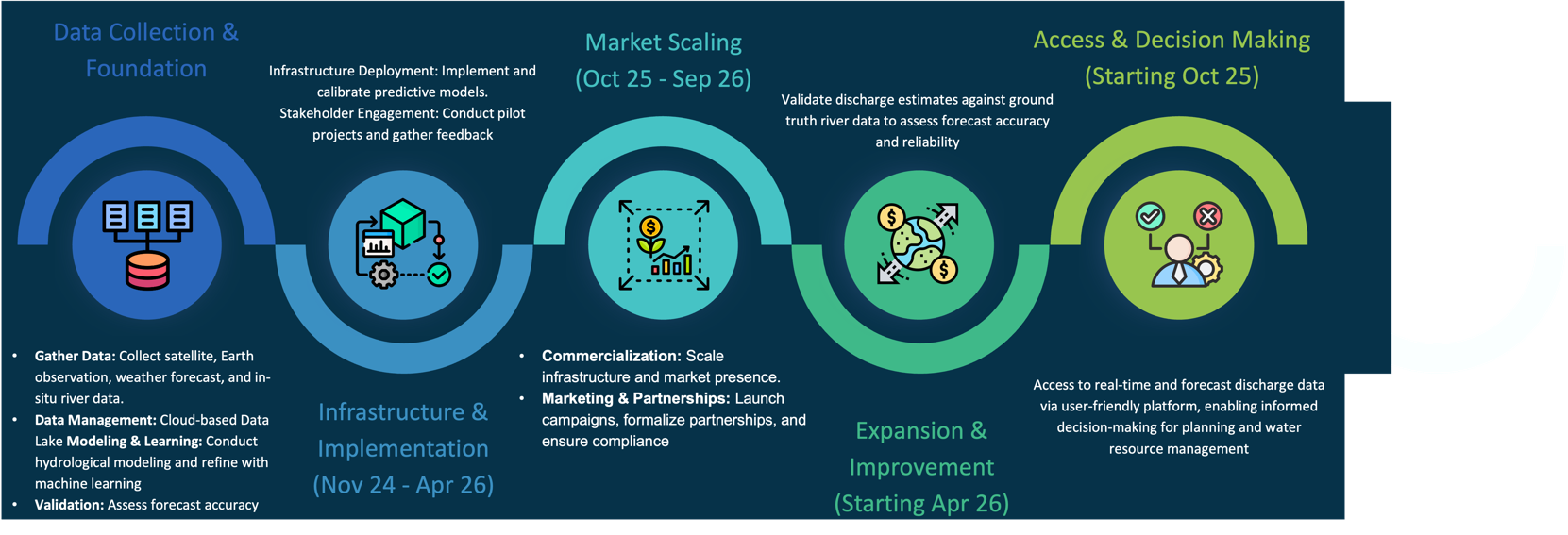
Data4Water's roadmap, to transition to the demonstration phase, consists of five key phases:
-
Data Collection & Foundation:
-
Gather Data: Collect satellite, Earth observation, weather forecast, and in-situ river data.
-
Data Management: Cloud-based Data Lake, Modeling & Learning: Conduct hydrological modeling and refine with machine learning.
-
Validation: Assess forecast accuracy.
-
-
Infrastructure & Implementation (Nov 24 - Apr 26):
-
Infrastructure Deployment: Implement and calibrate predictive models.
-
Stakeholder Engagement: Conduct pilot projects and gather feedback.
-
-
Market Scaling (Oct 25 - Sep 26):
-
Commercialization: Scale infrastructure and market presence.
-
Marketing & Partnerships: Launch campaigns, formalize partnerships, and ensure compliance.
-
-
Expansion & Improvement (Starting Apr 26):
-
Validate discharge estimates against ground truth river data to assess forecast accuracy and reliability.
-
Incorporate user feedback for continuous improvement and develop new features.
-
-
Access & Decision Making (Starting Oct 25):
-
Provide real-time and forecast discharge data via user-friendly platforms.
-
Enable informed decision-making for agricultural planning and water resource management.
-



